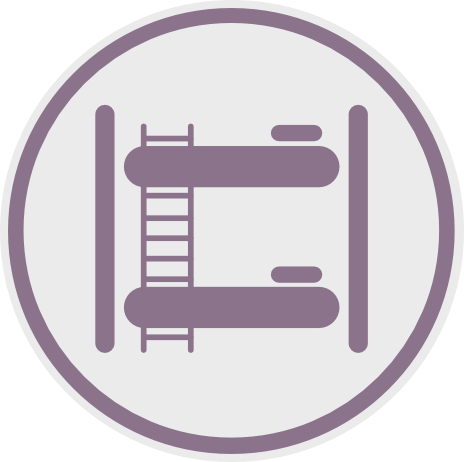Beryl Lopresti
Bunk Beds Sale: A Comprehensive Guide to Choosing the Right Bunk Bed for Your Home
Bunk beds have actually long been a staple in children's bed rooms, offering a mix of space-saving performance and enjoyable. Whether accommodating brother or sisters, good friends on slumber parties, or just optimizing a playroom, bunk beds have ended up being an important element in modern-day household homes. As sales on bunk beds increase, it becomes progressively crucial for customers to make informed decisions when acquiring one. This article will cover the fundamentals of acquiring a bunk bed, from types to safety features, along with ideas for maintaining the stability of your financial investment.
Kinds Of Bunk Beds
When thinking about a bunk bed sale, it's essential to understand the different styles offered on the market. Below are the most typical types:
Traditional Bunk Beds: These consist of two beds stacked one above the other, sharing a single frame. They are often the most cost-effective option.
L-Shaped Bunk Beds: This design features one bed positioned vertically and another horizontally. This plan creates additional space underneath the upper bed, which can be utilized for storage or a backyard.
Lofted Beds: Similar to traditional bunk beds but without any lower bed. Instead, the space beneath can be used for a desk, play area, or additional storage.
Triple Bunk Beds: For households with a larger number of children or frequent slumber parties, triple bunk beds supply three sleeping areas in a space-efficient style.
Futon Bunk Beds: These styles merge bunk beds and futon couches. The bottom section transforms into a separate seating area, enhancing performance.
Convertible Bunk Beds: These beds can be separated into two specific beds, making them flexible as kids's requirements alter in time.
Table 1: Comparison of Bunk Bed TypesTypeDescriptionSpace EfficiencyAdditional FeaturesTraditional Bunk BedTwo beds stacked verticallyHighMost basic designL-Shaped Bunk BedOne vertical and one horizontal bedModeratePlay or storage spaceLofted BedRaised bed with open space listed belowHighWork/play locationTriple Bunk BedThree stacked bedsExtremely HighAccommodates more usersFuton Bunk BedBunk bed with a convertible futonHighMulti-functionalConvertible Bunk BedCan be split into 2 different bedsModerateFlexibility & & longevitySecurity Features to Consider
Safety is paramount when buying a bunk bed. Below are key security functions to search for:
Guardrails: Adequate guardrails must exist on both sides of the upper bunk to prevent falls. They must be at least 5 inches higher than the bed mattress.
Ladder Design: Look for strong, broad ladders with slip-resistant rungs. Make sure that the angle is not too steep for easy access.
Stability: Ensure the bed is built with strong products, such as solid wood or sturdy metal. The bed needs to not wobble when in usage.
Weight Limit: Check the weight capability of the bunk bed to guarantee it can accommodate the designated users safely.
Material Safety: If possible, select beds made from non-toxic products or those fulfilling security requirements for kids's furnishings.
Table 2: Essential Safety FeaturesFunctionDescriptionValueGuardrailsSides of upper bed to avoid fallsImportant for kid securityLadder DesignStrong, slip-resistant rungsAids safe and simple accessStabilityBuild quality to avoid wobblingGuarantees security and durabilityWeight LimitMaximum weight capabilityAvoids accidentsMaterial SafetyNon-toxic, safe materialsProtects children's healthMaintenance Tips for Bunk Beds
To extend the life of your bunk bed and make sure continuous security, consider the following maintenance tips:
Regular Inspections: Periodically examine the structure for loose screws, bolts, or any indications of wear. Tighten fasteners as required.
Tidy Periodically: Dust and tidy the surface areas regularly. Usage appropriate cleaners that won't damage the finish.
Examine Weight Limits: Be conscious of weight limits, particularly with older kids or adults who might want to use the upper bunk.
Prevent Climbing on Guardrails: Educate children not to use guardrails for climbing or playing to lower the threat of accidents.
Regularly Asked Questions (FAQs)
Q1: What is the age limit for kids to securely utilize bunk beds?A: While it differs by the producer, lots of suggest that kids under six must not sleep in the upper bunk due to safety concerns.
Q2: How can moms and dads prevent unsafe climbing?A: Setting clear rules about bunk bed use and supervising kids can assist. Additionally, utilizing a bed tent can discourage climbing while producing an enjoyable sleep environment.
Q3: What should I think about when embellishing a room with bunk beds?A: Ensure there suffices space around the bunk bed for safe motion, and use the design to produce individualized areas for each child.
Q4: Is a lofted bed ideal for older children?A: Yes, lofted beds can be ideal for older children as long as they fulfill safety requirements and the child is accountable enough to use them securely.
Bunk beds serve a practical function while adding an aspect of fun to a child's bedroom. As sales of bunk beds continue to increase, mindful factor to consider of types, safety features, and upkeep practices is vital for moms and dads and caretakers. By understanding these essential elements, families can discover the best bunk bed for their home, making sure both functionality and security for many years to come. Whether it's for siblings sharing a space or producing a relaxing pajama party space, a well-chosen bunk bed can offer joy and functionality, making it a worthy investment.
Bunk beds have actually long been a staple in children's bed rooms, offering a mix of space-saving performance and enjoyable. Whether accommodating brother or sisters, good friends on slumber parties, or just optimizing a playroom, bunk beds have ended up being an important element in modern-day household homes. As sales on bunk beds increase, it becomes progressively crucial for customers to make informed decisions when acquiring one. This article will cover the fundamentals of acquiring a bunk bed, from types to safety features, along with ideas for maintaining the stability of your financial investment.
Kinds Of Bunk Beds
When thinking about a bunk bed sale, it's essential to understand the different styles offered on the market. Below are the most typical types:
Traditional Bunk Beds: These consist of two beds stacked one above the other, sharing a single frame. They are often the most cost-effective option.
L-Shaped Bunk Beds: This design features one bed positioned vertically and another horizontally. This plan creates additional space underneath the upper bed, which can be utilized for storage or a backyard.
Lofted Beds: Similar to traditional bunk beds but without any lower bed. Instead, the space beneath can be used for a desk, play area, or additional storage.
Triple Bunk Beds: For households with a larger number of children or frequent slumber parties, triple bunk beds supply three sleeping areas in a space-efficient style.
Futon Bunk Beds: These styles merge bunk beds and futon couches. The bottom section transforms into a separate seating area, enhancing performance.
Convertible Bunk Beds: These beds can be separated into two specific beds, making them flexible as kids's requirements alter in time.
Table 1: Comparison of Bunk Bed TypesTypeDescriptionSpace EfficiencyAdditional FeaturesTraditional Bunk BedTwo beds stacked verticallyHighMost basic designL-Shaped Bunk BedOne vertical and one horizontal bedModeratePlay or storage spaceLofted BedRaised bed with open space listed belowHighWork/play locationTriple Bunk BedThree stacked bedsExtremely HighAccommodates more usersFuton Bunk BedBunk bed with a convertible futonHighMulti-functionalConvertible Bunk BedCan be split into 2 different bedsModerateFlexibility & & longevitySecurity Features to Consider
Safety is paramount when buying a bunk bed. Below are key security functions to search for:
Guardrails: Adequate guardrails must exist on both sides of the upper bunk to prevent falls. They must be at least 5 inches higher than the bed mattress.
Ladder Design: Look for strong, broad ladders with slip-resistant rungs. Make sure that the angle is not too steep for easy access.
Stability: Ensure the bed is built with strong products, such as solid wood or sturdy metal. The bed needs to not wobble when in usage.
Weight Limit: Check the weight capability of the bunk bed to guarantee it can accommodate the designated users safely.
Material Safety: If possible, select beds made from non-toxic products or those fulfilling security requirements for kids's furnishings.
Table 2: Essential Safety FeaturesFunctionDescriptionValueGuardrailsSides of upper bed to avoid fallsImportant for kid securityLadder DesignStrong, slip-resistant rungsAids safe and simple accessStabilityBuild quality to avoid wobblingGuarantees security and durabilityWeight LimitMaximum weight capabilityAvoids accidentsMaterial SafetyNon-toxic, safe materialsProtects children's healthMaintenance Tips for Bunk Beds
To extend the life of your bunk bed and make sure continuous security, consider the following maintenance tips:
Regular Inspections: Periodically examine the structure for loose screws, bolts, or any indications of wear. Tighten fasteners as required.
Tidy Periodically: Dust and tidy the surface areas regularly. Usage appropriate cleaners that won't damage the finish.
Examine Weight Limits: Be conscious of weight limits, particularly with older kids or adults who might want to use the upper bunk.
Prevent Climbing on Guardrails: Educate children not to use guardrails for climbing or playing to lower the threat of accidents.
Regularly Asked Questions (FAQs)
Q1: What is the age limit for kids to securely utilize bunk beds?A: While it differs by the producer, lots of suggest that kids under six must not sleep in the upper bunk due to safety concerns.
Q2: How can moms and dads prevent unsafe climbing?A: Setting clear rules about bunk bed use and supervising kids can assist. Additionally, utilizing a bed tent can discourage climbing while producing an enjoyable sleep environment.
Q3: What should I think about when embellishing a room with bunk beds?A: Ensure there suffices space around the bunk bed for safe motion, and use the design to produce individualized areas for each child.
Q4: Is a lofted bed ideal for older children?A: Yes, lofted beds can be ideal for older children as long as they fulfill safety requirements and the child is accountable enough to use them securely.
Bunk beds serve a practical function while adding an aspect of fun to a child's bedroom. As sales of bunk beds continue to increase, mindful factor to consider of types, safety features, and upkeep practices is vital for moms and dads and caretakers. By understanding these essential elements, families can discover the best bunk bed for their home, making sure both functionality and security for many years to come. Whether it's for siblings sharing a space or producing a relaxing pajama party space, a well-chosen bunk bed can offer joy and functionality, making it a worthy investment.
Made By Owner Card
 Italian
Italian
 हिन्दी
हिन्दी
 Arabic
Arabic
 Chinese
Chinese
 English
English
 French
French
 German
German
 Portuguese
Portuguese
 Russian
Russian
 Spanish
Spanish
 Turkish
Turkish

